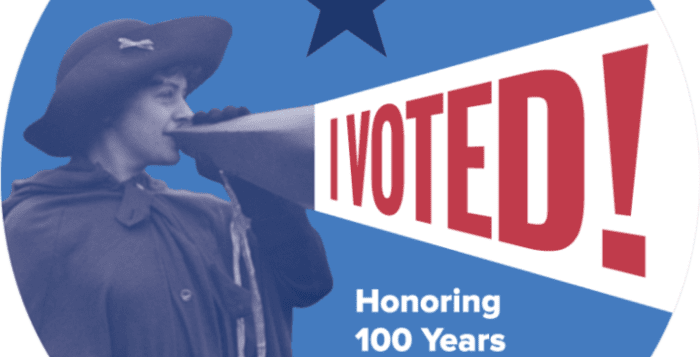Making Democracy Work: Women in New York State won the vote 100 years ago next week
By Lisa Scott
On Election Day next week, you may be offered a blue sticker that says “I Voted.” If you take a closer look, you might wonder why it has a quaint and old-fashioned image with the words “Honoring 100 Years of a Woman’s Right to Vote.” For every one of us that struggle, the victory and the legacy made a tremendous difference in our lives, rights and American democracy today.
The sticker’s image, chosen by public vote across New York State, is Long Island’s Rosalie Gardiner Jones (yes, that Gardiner’s Island and that Jones Beach!). Far from being a grandmotherly, stern face in a photograph, Jones was a flamboyant young socialite from the Oyster Bay-Cold Spring Harbor area who, much to the dismay of her anti-suffragist mother, preferred campaigning for women’s suffrage over the performance of her social duties.
Always with an eye for publicity, in 1912 she joined fellow suffragette Elisabeth Freeman in a trek across Long Island in a horse-drawn carriage to distribute suffrage pamphlets and literature, and in December of that year received much publicity for leading a 170-mile, 13-day march in the midst of winter from the Bronx to Albany to deliver petitions to the governor, demanding a woman’s suffrage amendment in the NYS Constitution.
Jones believed that the movement should exhibit a more military stance and discipline and thus began calling herself “The General.” She carried the suffrage message into small towns and villages with a personal attention that was both impassioned and provocative. After suffrage was achieved, she continued to campaign for equal rights and social reform until she died in 1978.
New Yorkers have long led the struggle for women’s rights; a fight with diverse people and disparate ideas (people disagreed vehemently for years about goals, partners and methods to further the cause). Seneca Falls is considered the birthplace of the women’s rights movement, and some of its greatest leaders, from Susan B. Anthony to Matilda Joslyn Gage and Elizabeth Cady Stanton (who summered in Shoreham with her suffragist daughter and family), did their pioneering work in the Empire State. In passing women’s suffrage in 1917, New York fueled the momentum for the entire nation to follow suit three years later.
Women vote today because of the women’s suffrage movement, a courageous and persistent political campaign that lasted over 72 years, involved tens of thousands of women and men and resulted in enfranchising one-half of the citizens of the United States. Inspired by idealism and grounded in sacrifice, the suffrage campaign is of enormous political and social significance, yet it is virtually unacknowledged in the chronicles of American history.
For women won the vote. They were not given it, granted it or anything else. They won it as truly as any political campaign is ultimately won or lost. And they won it, repeatedly, by the slimmest of margins, which only underscores the difficulty and magnitude of their victories. It was a movement of female organizers, leaders, politicians, journalists, visionaries, rabble rousers and warriors. It was an active, controversial, multifaceted, challenging, passionate movement of the best and brightest women in America, from all backgrounds, who, in modern parlance, boldly went where no woman had ever gone before.
The suffrage movement holds a particular relevance now as it has helped lead us as a country and a people to where we are today. It celebrates rights won and honors those who helped win them. It puts women into our national history as participants. It reminds us of the necessity of progressive leaders, organizers and visionaries in every local community. The legacy of those women and men 100 years ago is democracy at work for all: civil rights, gender diversity, equality and civic engagement.
For more about our local suffragists, read Antonia Petrash’s book, “Long Island and the Woman Suffrage Movement.” For thought-provoking insights on the suffrage movement and its legacy, read Robert Cooney’s essay, “Taking a New Look — The Enduring Significance of the American Woman Suffrage Movement,” and his comprehensive book, “Winning the Vote: The Triumph of the American Woman Suffrage Movement.”
Lisa Scott is the president of the League of Women Voters of Suffolk County, a nonprofit, nonpartisan organization that encourages the informed and active participation of citizens in government and influences public policy through education and advocacy. For more information, visit www.lwv-suffolkcounty.org, email [email protected] or call 631-862-6860.







